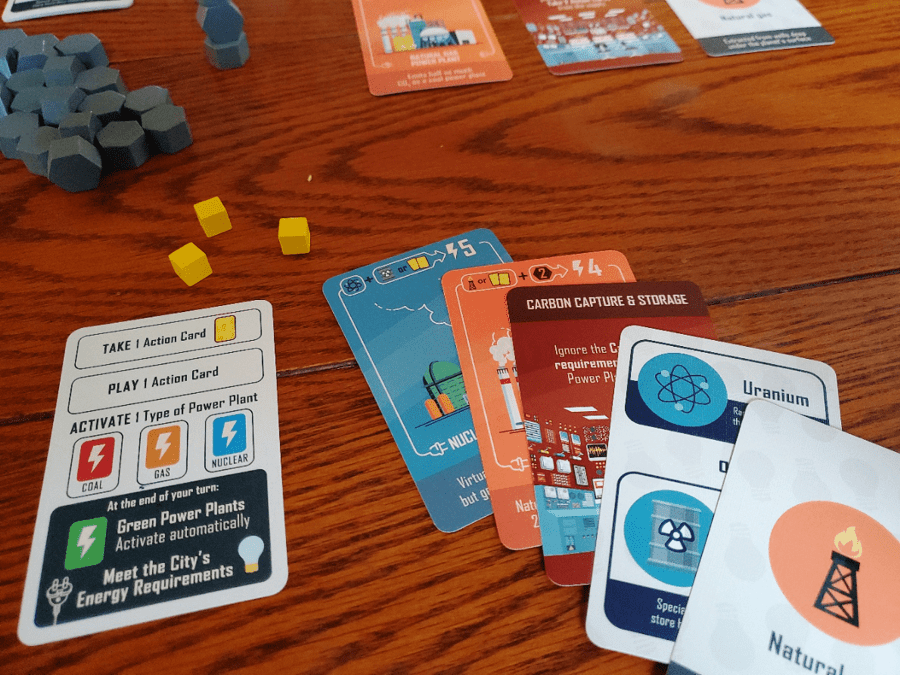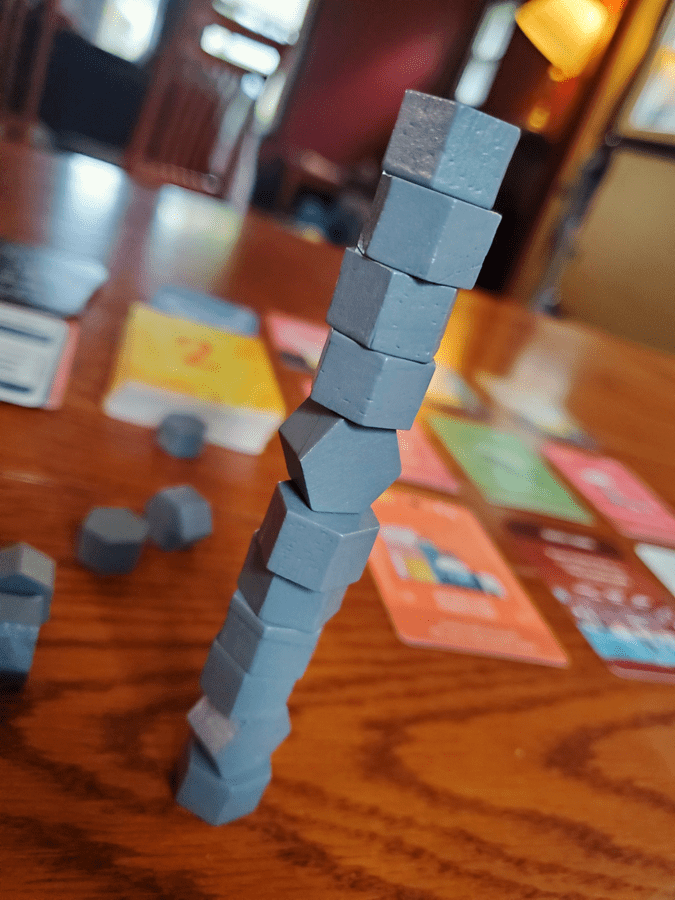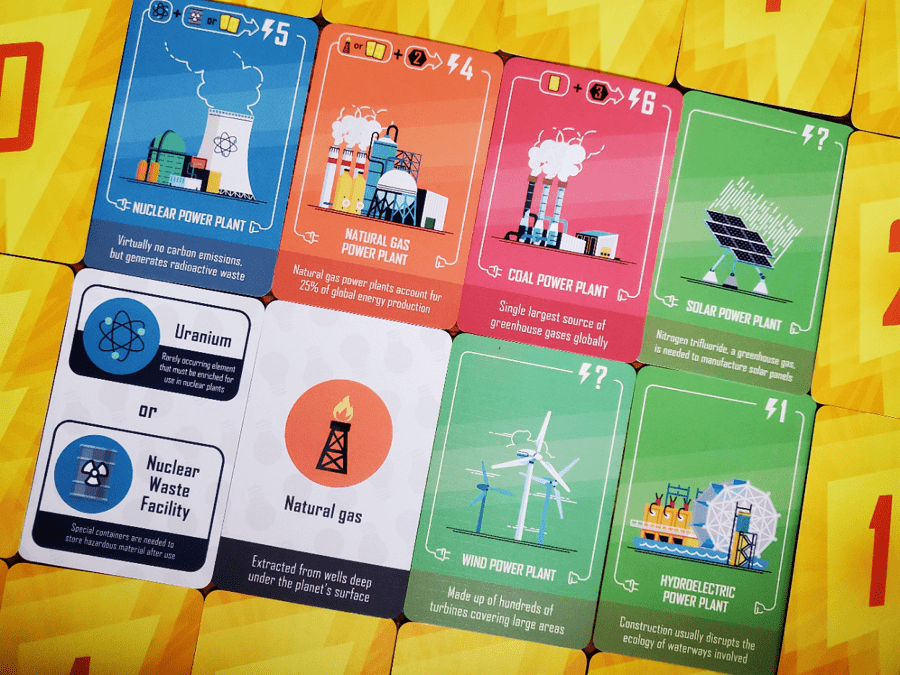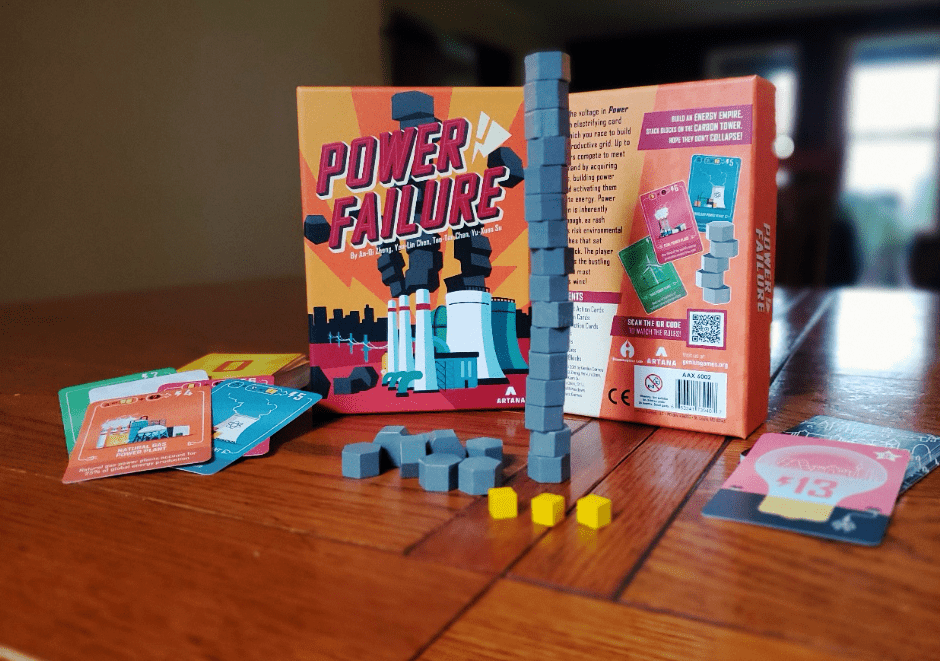As a homeschool dad, I tend to take an interest in games that seem like they belong in a classroom. In fact, one of our favorite homeschool decisions has been to include chess from the beginning as a regular subject for the development of strategic thinking. I’d imagine this has served to prepare my kiddos for all manner of tabletop games. We’ve grown to really enjoy games that interact with science, history, and real world issues, even if on a very minor scale.
Our introduction to Artana Games came when we picked up a never-played deluxe version of Lovelace & Babbage at a sidewalk sale. We were immediately won over. (Even if the seller had removed the exclusive Ada Lovelace lapel pin from the box before selling! Travesty! It’s OK. I’m OK.) Their partnership with Genius Games has only made that publishing combo a tour de force on our game shelf.
Naturally, then, we jumped at the chance to play Power Failure, an English reprint of a 2018 release called Power On! I’ll include some of the differences between the two versions in my thoughts below.
Setup
The first thing you’ll need to play Power Failure is a set of sturdy legs. Table legs, that is. While you’re at it, you might want to make sure the dog is in another room altogether. Any game that requires the creation of an unstable tower, no matter the girth, demands as much. Beyond that, the game consists of three small cubes, 78 cards, and two dozen hex carbon blocks.
Four Edisonian City cards line the top of the play area. These cards represent the electrical demands of a metropolis of sorts, target customers of the players’ power empires. Each card also shows the reward, in victory points, for meeting that demand. These are the cards over which players will engage in carbon-ish combat.
The deck of Action cards—power plants, resources, and special events—lies in wait below the city. Players deal six cards face-up to form the supply, flip one to prime the discard pile, and deal five cards to each player. The remaining Action cards rest near the supply, face-down.

Aspiring megawatt magnates then receive a special card that serves as a player mat, which shows the possible actions available on each turn. The small power cubes serve the absent-minded by marking completed actions along the way.
Finally, the small but menacing carbon tower is set up within reach of the players. Depending on the desired difficulty of the group, three hex-shaped carbon blocks can be stacked flat or on end, creating varying levels of (in)stability for the strategic challenge ahead.

Gameplay
Players must take three actions on each turn, marking the mat with a power cube after each:
- Take 1 Action card from the supply.
- Play 1 Action card. This might include laying a power plant into your personal grid or triggering a helpful event.
- Activate 1 type of Power plant—coal, natural gas, or nuclear—attempting to harness precious watts. Notice I said attempting.
Cue the carbon tower. As certain actions are performed, players must add one carbon block to the tower, decreasing stability and increasing table tension. For example, playing a power plant into the grid, no matter the type, requires one harmless carbon block. No problem. Activating coal plants, on the other hand, requires three blocks each. Houston? Hello? Houston, are you there?

If at any time during a player’s turn they cause even a single carbon block to drop, the tower is considered collapsed. The offending player’s turn ends immediately, with the current action going unfulfilled. All players must then feel the setback by discarding one Action card before resetting the tower at three before play continues.
Each power plant presents a cost of activation, typically a combination of resource and Action cards. Coal, for example, costs one discard and 3 carbon blocks. Natural gas, on the other hand, requires either a gas card or two randoms, plus 2 carbons. Nuclear avoids the pesky carbon cost, but requires the acquisition of Uranium/Waste storage from the Action deck. Green energy activates automatically on each turn, which sounds great. However, green is easily the least efficient, providing energy at the whims of nature, determined in most cases by the number showing on the back of the deck of Action cards.

If the tower remains intact, each player’s turn ends by counting the activated energy and visiting the City cards to see if any may be claimed. The game’s end is triggered when the visible City cards cannot be replenished in full. Victory point totals determine the winner. Plain and simple.
Reprint
For those who may have a familiarity with the original Taiwanese printing, there are quite a few small differences between Power Failure and Power On!, although I would guess (having not played the original) the overall experience is similar. The artwork from Masha Tace has not changed, but the rulebook has been redesigned.
Here, the hand limit has been decreased from 8 to 6, creating more tension with regard to both plant activation and the treacherous discard requirement of the collapsed carbon tower. Available city cards have been increased from 3 to 4, which moves the game along in pacing. The various power plant outputs have received minor adjustments as well. Perhaps the most jarring rule of the original was the loss of the next turn when the tower collapses. Thank you, Artana, for maintaining steady player activity in the new release!
Thoughts
My thoughts on Power Failure read like one of those carnival rides that toss you and your cookies all over the place.
I do not have a steady hand. Therefore, any game that requires the building and maintenance of a stack of anything will be a struggle for me, but a challenge I willingly accept. (If you are into dexterity and stacking, check out our reviews for Meeple Circus, Beasts of Balance, and Tuki.) However, with Power Failure, Tao-Tao Chen and this team of designers has managed to create an interesting blend of strategy and pacing to offset the dexterity aspect. It is possible to play without engaging the carbon tower all that much—meaning I can hunker down, set my elbows, steady one hand with the other and hope for the best on that precarious pile of wooden hexes without excessive fear because the tower is not the entirety of the game.
Power Failure is a slightly different experience at each player count. For two players, it feels most like a race. Because the Action card deck does not change, resources are more readily available and the game boils down to managing the supply in hot pursuit of a heap of City cards. At four players, it is entirely possible for the carbon stack to rise and fall rhythmically, seemingly punishing one player with tower instability for consecutive rounds until someone is forced into an adjustment, thereby establishing a new rhythm. The sweet spot seems to be three, where speed, card distribution, and tower treachery live in harmony.
Perhaps the most troubling aspect of the game is the number of times players were left without fruitful actions on the final turn. Because the endgame is dependent on a lack of City cards, it is far too likely that the three granted actions will be insufficient to pull off some grand and desperate attempt at last-minute glory. To the contrary, the winner is often decided (not long) before the final turn, creating endings that can fizzle rather than bang. This is not a killer, but neither is it a helper!

Thematically, I expected a game about carbon usage to communicate a message of some sort, either through flavor text or gameplay. Why choose a title that suggests failure rather than success? Is this all part of some attempt at an implicit lesson? I didn’t find the details to be preachy, but that doesn’t mean there isn’t an opportunity to consider ways in which the game is analogous to reality if you’re into that sort of thing.
Indeed there is information on each of the cards about the type of energy being produced, and the diversity of power sources seems to be appropriately depicted. Nuclear is potent, but uranium and storage are limited. Coal and natural gas are lucrative, but require dangerous interaction with the tower that impacts the whole table. Green energy is unpredictable and, therefore, requires multiple iterations and the patience to strike when the iron is hot. It all makes sense. Winning strategy, though, typically requires neither diversity nor moderation, but a headlong dive into one plant type supplemented by a smattering of green options and a few surprisingly helpful events. If anything, the game throws on the blinders as players attempt to produce energy in the straightest line possible with little concern for, well, anything. Maybe that’s the message? Maybe there is no message at all and I just like to think about games.
As an educational endeavor, there is no doubt the kids picked up on the tight situation within the game. The more daring and dextrous of the bunch typically adopted the coal strategy, knowing they could push the game to the brink (some kids just want to watch the world burn) and leave it there for the less steady (i.e. their father), who in their pursuit of the friendly carbon neutrality of nuclear energy often lamented the lack of storage cards necessary to use it to its full potential. Throughout the game, there was a wide open door to conversation about why they were making their decisions, how the game reflected a challenging reality, and how their attempted solutions, while occasionally profitable, were murky at best. Sometimes recognizing the tension is the lesson.
Overall, I enjoyed Power Failure. I am often amazed by the variety and blend of mechanics possible with small box games. I can’t say it blew my mind, but it was something different, and something to talk about. I can see it coming to the table as a filler from time to time, especially when the group and player count are right.
One Year Later…
Power Failure stayed with us for most of this year, but recently fell victim to a trade. We played sparsely during that time, but in the end the dexterity blend is definitely a game that requires a bit of a mood in our house. I could see us acquiring this game a second time as the trade winds blow. Small boxes often provide wonderful balance in trades, after all. But for now, we’re happy to have pulled quite a few plays out of the box before bestowing the game on another family. For a $15 box, I’d say we definitely got our money’s worth here. If the subject matter and dexterity aspect sound appealing, I still say give it a try.












Add Comment